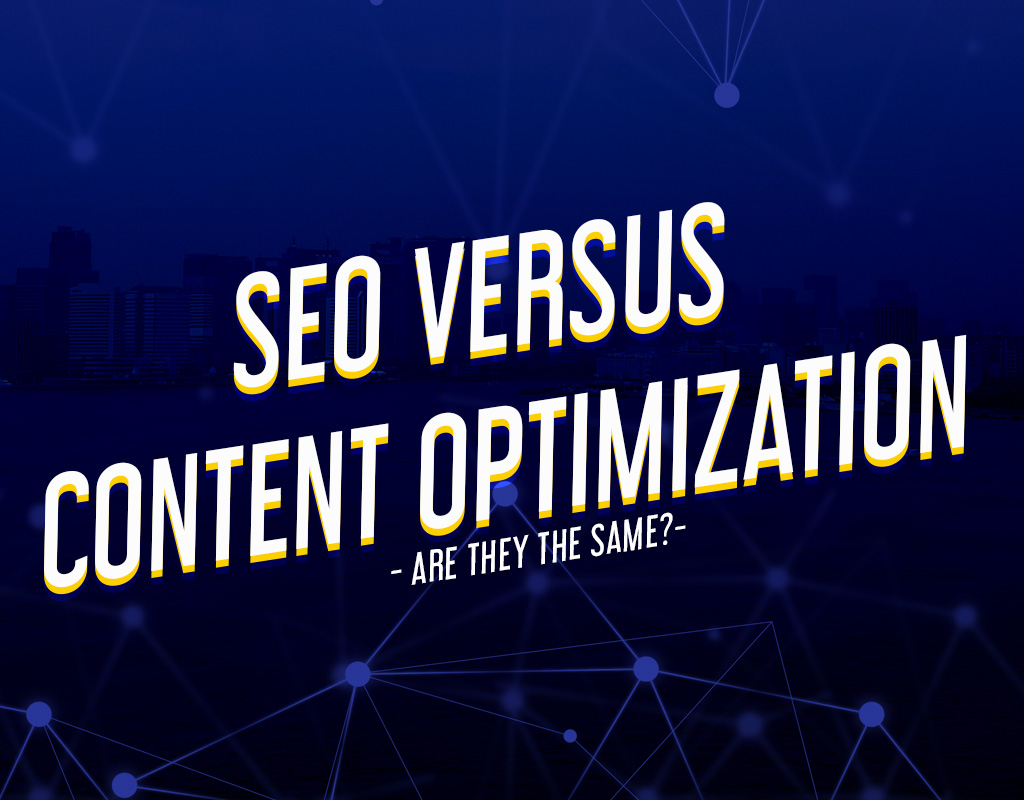You might have heard the terms Search Engine Optimization and content optimization, but do you know the two are very different concepts despite the fact that both items helps with your website’s search results rank? I’m here to tell you the differences and similarities between the two. After all, knowledge is power.
The Married Couple
Sure, you’ve seen these two words tossed around, and you might have seen them in an article. There’s a possibility you might have read that content enforces SEO and vice versa. They’re both a married couple you can’t live without in today’s fast-paced world. However, what does it mean to someone who’s just stepping into the world of SEO and content optimization? First, let’s define the two terms.
Search Engine Optimization (SEO): This is the practice of increasing your online visibility by employing organic methods to rank in the search engines. Keyword usage defines SEO.
Content optimization: The practice of optimizing content to inform the user about you and your brand. With written material posted on the website, the search engine crawls and indexes it. However, content isn’t restricted to just only articles; these can also be in the form of images, infographics, videos, and podcasts!
Moreover, Google looks at the site’s meta titles, descriptions, and even alt texts, too.
See the difference yet? SEO is all about keywords that assist in ranking your website naturally. Content optimization uses those keywords in a sentence to help get your website ranked and recognized. However, before I delve into the gears and cogs about the two, let’s talk about our best friend, Google.
A Small Lesson About Google
Google has long since evolved from the keyword ranking treasure hunter to a nit-picky auctioneer that only displays relevant websites on its shining mantle. Over the years, Google went through facelifts and delivered change. Google Panda, released in 2011 allowed the engine to rank sites and push down (or eliminate) low-quality sites. Sites affected were spammy websites, content farms, or places which are unnaturally ranked. Long story short: if Google views a site as poor or spammy, it’s bye bye website on the first page (or worse, forever). Websites that Google deems educational and fits the bill are shown first.
In 2013, Google launched its Hummingbird algorithm designed to match answers to questions typed in the search engine. Between 2013 to 2015, the company continuously refined the way Hummingbird fetches and displays, and it was a game-changer.
Wait, you ask. How does this relate to SEO and content optimization? More than you’d think!
More Than Meets the Eye
We’ve covered the necessary details about SEO, content, and Google, but what else do you need to know to get ahead of the game. As someone who wants to get their name out there and fully optimized for Google search, you have to put in the effort and hard work. There are no shortcuts to success. How could you put yourself out in the world without resorting to dirty tactics? Believe it or not, dirty tactics still exist in the SEO world. That’s a big no-no.
As you want Google to rank your keywords, you need to devise keywords you think apply to you and your brand. You’ll need to think of short and long-tail keywords. Once you’ve established your keywords, you need to find a way to incorporate them into your material. One thing of note, however, is to avoid keyword stuffing.
Keyword Stuffing
Oh no, what’s that?! Keyword stuffing is when you pack your website with keywords and synonyms related to it without a coherent sentence structure. Let’s imagine your website is about selling chairs. You’re not sure what to do and well, you do this.

…Chairing is caring.
Big no-no. You must use the keywords naturally and don’t forget to link to other websites. Go ahead and link between your pages; anything that tells the search engine you’re putting in the effort to make your site rank!
As discussed above, content isn’t restricted to articles; play around with infographics, video, and podcasts. The titles of those pieces serve as keywords, too. Create content you feel your audience will gravitate to and want more of. Don’t feel discouraged if you think people aren’t liking or sharing your content; it’s all about trial and error. Content defines keywords and shows the world what you’re really about.
A Blooming Analogy
Imagine this: your SEO keyword is a seed, a seed that can’t grow on its own. Content optimization is fertilizer and water. Consider this: you want your seed to grow, but first, you need to pick the right compost for it. That’ll be your content. You can’t just write whatever you want and add keywords to it, that’s not how it works. Similar to compost, you have to find the correct content to support your chosen keywords. Of course, you need to put in your heart and soul if you want it to bloom.
My point is, the more you nurture it, the better shot at success you have. When conditions are met, the seed will grow into a beautiful sunflower. Dramatic, I know.
BE ORGANIC
Everything you do must be organic, and in due time, Google will recognize your efforts and work its magic. Keep in mind, however, your keywords and website won’t rank overnight.
So, what have we learned? Here’s the quick recap. SEO is dependent on keywords to assist online visibility. Content optimization is SEO’s support system that tells Google, “Hey, check this out! You’re looking for this, right? We have the answers for you!” The name says it all: Content optimization, you make content relevant.
I hope this short-ish lesson helped you to better understand the differences between SEO and content optimization. They’re both related, but not the same. You can’t have one without the other is what I’m saying!
Sincerely,
Narisa (The Wordsmith)
Digital Marketing Enabler

